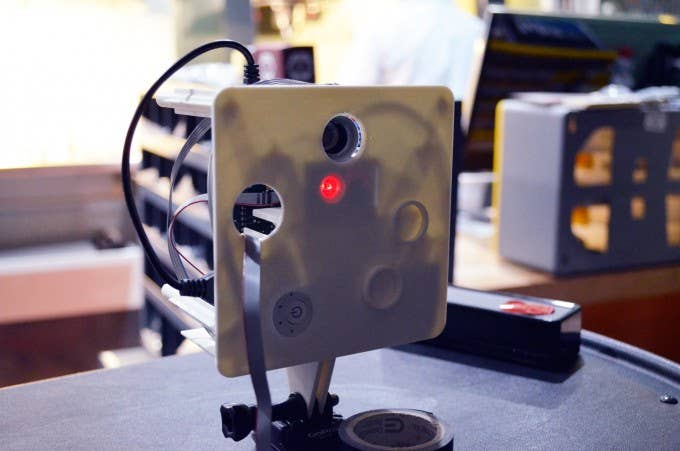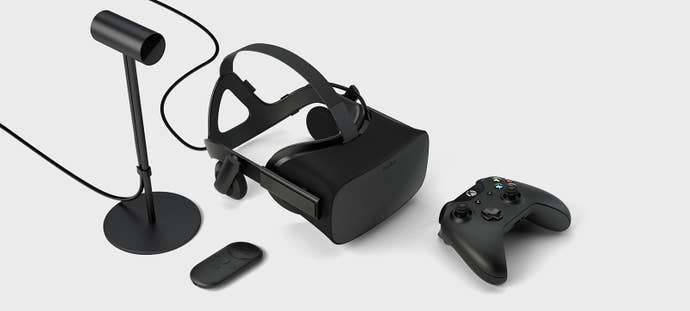The Hype Dissected: What VR Really Means For Gaming
COVER STORY: What drives the hype behind VR? We talked to people at every level of the industry to find out.
This article first appeared on USgamer, a partner publication of VG247. Some content, such as this article, has been migrated to VG247 for posterity after USgamer's closure - but it has not been edited or further vetted by the VG247 team.

Back to the '90s
During GDC, I wrote that it's basically 1995 all over again for a lot of VR developers. "The painstaking progress in developing workable 3D cameras and controls has all but been erased with PlayStation VR and Oculus on the scene. It's like we've gone back 20 years to the early days of the PlayStation 1, when developers were working with 3D cameras for the first time. Developers now have to ask themselves basic questions like, 'How can we make it easy to interact with objects?' and 'How can we make it so people can play for an extended period of time without throwing up?'"
Even more ambitious VR games like Adr1ft - where you're an astronaut spinning through space - feel curiously limited in their scope. One of the hottest VR demos at GDC was a first-person shooter called Bullet Train, which circumvented the problem of motion sickness by having you teleport around a train station. Aiming and firing a gun was undeniably cool, but its limitations were obvious, and its sense of immersion was hampered by a distinct lack of weight.
Motion sickness, incidentally, is a big problem for VR. Boosters have argued that higher framerates and better resolution will resolve many of the issues associated with nausea, but Oculus VR co-founder Jack McCauley disagrees. At a talk he gave to the MEMS Executive Congress last fall, he stated on a slide: "High refresh rates and high render rates do not relieve motion sickness, they only add unnecessary cost to VR systems."
I can agree with this based on personal experience. I was told that motion sickness wouldn't be as much of a problem, but I found myself struggling to finish several demos due to a sudden rush of nausea. It's a big problem for first-person games in particular, which should be a natural fit for VR headsets. Call of Duty VR would be amazing if not for the fact that you'd probably want to puke by the second big setpiece.
When I talked to McCauley recently, he explained that a lot of this down to the inner ear being a tricky thing that is still not well understood. "The greatest source of information on motion sickness and vestibular issues comes from the military research, and all the indications are that it has to do with the subtleties of the inner ear and microadjustments to posture and head position to keep your head pointed in the same direction as your ears are, if you can understand that. The ocular system and the vestibular system are located right next to each other in the brain for a reason. The neural pathways are very short, and the reaction time is very short. If you miscue that system by providing false cues to either one, it can cause some pretty nasty side effects."

Since leaving Oculus VR, McCauley has devoted much of his time to solving this issue. When I interviewed him recently, he told me that he doesn't believe that camera-based solutions like the one used by PlayStation VR will ultimately work. Instead, he's working on a laser-based tracking system that actively seeks its intended target, as detailed in this in-depth look at on Road to VR.
Weight is another issue that McCauley doesn't think can really be solved, at least with traditional games. It's one reason McCauley is skeptical about even established genres like cockpit games. "I don't think a cockpit game is a good VR experience, because with a cockpit game, you don't feel - like a driving game going around a corner - you feel no Gs. You're sitting there, and you can look and you can see the games next to you, you can go around the corner and you can see your feet on the brake pedals. Big deal. That's just kind of gimmicky."
As McCauley works on big picture issues like motion sickness, individual developers are grappling with a whole new game development vocabulary. Patrick Harris is an experienced developer who has worked on games ranging from The Bigs to Dead Rising 2; but in working on Time Machine VR, he says he's made plenty of mistakes. "A lot of game designs fundamentals that are really established in, finger quotes, traditional games don’t work in VR. A silly one that I learned that I was talking about earlier today is, there’s no corner of the screen. We're used to going, 'Oh, here's a health bar, or a timer, or whatever, ammo counter,' putting it in the corner of the screen."

The Headsets: Oculus Rift
$599, Oculus VR
One of the earliest examples of the current generation of commercial VR, the Oculus Rift caught fire thanks to this 2012 Kickstarter video. In 2012, Oculus VR was acquired by Facebook, lending further legitimacy to the headset. Its early popularity has made it virtually synonomous with VR; and at $599, it's cheaper than its main competition, the HTC Vive. The Rift launched with 30 games on March 28.
"I'm used to being able to direct a player’s view in a traditional game, going, I want to grab this camera and force you to look at this door while the monster jumps through it, so I know you experience it. But in VR I can't do that. If I grab your head and turn it, it'll make you throw up instantly. So, we have to design with a lot more subtlety and a lot more acceptance that a player might not always be looking exactly where you want them to. You have to encourage them and try to get them to look at it, but it’s not going to happen every time. So, it changes how you pace experiences and design those same experiences."
These sorts of design challenges will eventually be ironed out. Even the issues with motion sickness will probably be addressed. In many respects, VR is still in just its infancy, which makes its future all the more difficult to imagine. But with Rift and Vive now available, game developers are being asked to envision that future now, and the results are as interesting and messy as you might expect.
Grappling with the possibilities
When the Oculus Rift launched a couple weeks ago, its initial run of games included, among others, a tower defense game - not exactly a genre that you would associate with VR. Granted, Defense Grid have some merit, but it's nevertheless an example of developers trying to match new technology to an old paradigm. It brings to mind the awkward attempts to port classic platformers and complex strategy games to smartphone when the App Store first arrived on the scene. It rarely worked well.
VR game development, as you might expect, is still mostly a work in progress. Job Simulator, one of the Vive's bundled games, is hilarious, but also slightly awkward as you try to manipulate objects using the motion controllers. Chronos has earned praise in some quarters; but as a third-person action game, it's an awkward fit for VR, with the POV being centered in a pre-determined spot in each room. Time Machine VR puts you in a time pod and sends you on a quest to observe prehistoric animals in a manner reminiscent of the full-motion video games of the mid-1990s, only with considerable more freedom (though with the same cheesy video clips). Other games, like theBlu - an underwater exploration game - are pure eye candy.
The games that have earned the most praise so far have been more tailored to the VR experience. Vanishing Realms - a Vive dungeon crawler that is currently in Early Access on Steam - marries actual movement with teleportation and motion control-based combat to effectively put you in the middle of Dungeons & Dragons, while EVE Valkyrie gives you the sense that you're actually flying a spaceship. The latter, in particular, feels like the realization of the potential of the genre, despite McCauley's criticism.


.jpg?width=291&height=164&fit=crop&quality=80&format=jpg&auto=webp)





